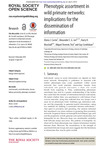Phenotypic assortment in wild primate networks
| dc.contributor.author | Carter, Alecia J. | en_US |
| dc.contributor.author | Lee, Alexander E. G. | en_US |
| dc.contributor.author | Marshall, Harry H. | en_US |
| dc.date.accessioned | 2016-07-30T01:39:19Z | |
| dc.date.available | 2016-07-30T01:39:19Z | |
| dc.date.issued | 2015 | en_US |
| dc.identifier.other | HPU4160494 | en_US |
| dc.identifier.uri | https://lib.hpu.edu.vn/handle/123456789/22390 | en_US |
| dc.description.abstract | Individuals’ access to social information can depend on their social network. Homophily—a preference to associate with similar phenotypes—may cause assortment within social networks that could preclude information transfer from individuals who generate information to those who would benefit from acquiring it. Thus, understanding phenotypic assortment may lead to a greater understanding of the factors that could limit the transfer of information between individuals | en_US |
| dc.format.extent | 13 p. | en_US |
| dc.format.mimetype | application/pdf | en_US |
| dc.language.iso | en | en_US |
| dc.subject | Biology | en_US |
| dc.subject | Behaviour | en_US |
| dc.subject | Ecology | en_US |
| dc.subject | Social network | en_US |
| dc.subject | Social information | en_US |
| dc.subject | Phenotypic assortment | en_US |
| dc.title | Phenotypic assortment in wild primate networks | en_US |
| dc.type | Article | en_US |
| dc.size | 934KB | en_US |
| dc.department | Education | en_US |
Files in this item
This item appears in the following Collection(s)
-
Education [806]

